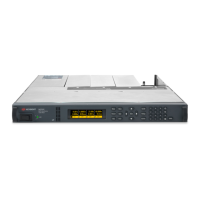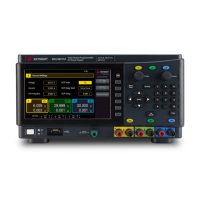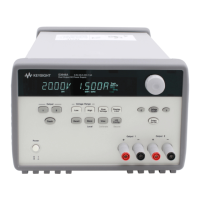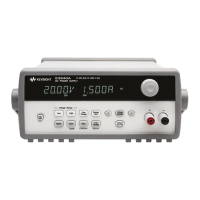Step 3. Record the output voltage reading from the DMM and the voltage measured over the
interface. The readings should be within the limits specified in the test record form for the appropriate
model under “Voltage Programming & Readback, Minimum Voltage”.
Step 4. Program the instrument settings as described in the test record form under “Voltage
Programming & Readback, High Voltage”.
Step 5. Record the output voltage reading from the DMM and the voltage measured over the
interface. The readings should be within the limits specified in the test record form for the appropriate
model under “Voltage Programming & Readback, High Voltage”.
Constant Voltage Load Effect
This test measures the change in output voltage resulting from a change in output current from full
load to no load.
Step 1. Turn off the power supply and connect a DMM and an electronic load (see Test Setup A).
Step 2. Turn on the power supply and program the instrument settings as described in the test record
form under “CV Load Effect”.
Step 3. Set the electronic load for the output current as described in the test record form under “CV
Load Effect”. The output status should be “CV”. If it isn’t, adjust the load so that the output current
drops slightly.
Step 4. Record the output voltage reading from the DMM.
Step 5. Open the load. Record the voltage reading from the DMM again. The difference between the
DMM readings in steps 4 and 5 is the load effect, which should not exceed the value listed in the test
record form for the appropriate model under “CV Load Effect”.
Constant Voltage Ripple and Noise
Periodic and random deviations in the output combine to produce a residual AC voltage superimposed
on the DC output voltage. This residual voltage is specified as the rms or peak-to-peak noise in the
indicated frequency range (see Specifications).
Step 1. Turn off the power supply and connect an electronic load, differential amplifier, and an
oscilloscope (ac coupled) to the output (see Test Setup C).
Step 2. As shown in the diagram, use two BNC cables terminated by a 50 Ω resistor to connect the
differential amplifier to the + and - output terminals. The shields of the two BNC cables should be
connected together. Connect the output of the differential amplifier to the oscilloscope with a 50 Ω
termination at the input of the oscilloscope.
Step 3. Set the differential amplifier to multiply by ten, divide by one, and 1 MΩ input resistance. The
positive and negative inputs of the differential amplifier should be set to AC coupling. Set the
oscilloscope’s time base to 5 ms/div, and the vertical scale to 10 mV/div. Turn the bandwidth limit on
(usually 20 MHz), and set the sampling mode to peak detect.
7 Verification and Calibration
312 Keysight N6900/N7900 Series Operating and Service Guide
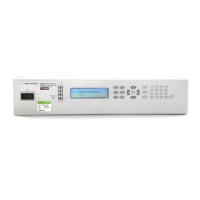
